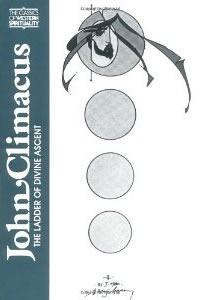Book Notes
 John Climacus, The Ladder of Divine Ascent, translated by Colm Luibheid and Norman Russell, Introduction by Kallistos Ware (New York: Paulist Press, 1982), 301pp.
John Climacus, The Ladder of Divine Ascent, translated by Colm Luibheid and Norman Russell, Introduction by Kallistos Ware (New York: Paulist Press, 1982), 301pp.
Like many of the mothers and fathers of the early church, we know little about the life of John Climacus or, in the Greek, "John of the Ladder" (?579–649?). "Hardly anything is known about the author," writes Colm Luibheid in his preface, except that "he passed forty years of solitude at a place called Tholas; that he became abbot of the great monastery of Mount Sinai, and that he composed there the present text." But no one disputes the enormous influence of the work that gave him his name. "With the exception of the Bible and the service books," writes Kallistos Ware in the introduction, "there is no work in Eastern Christendom that has been studied, copied, and translated more often than The Ladder of Divine Ascent. Every Lent in Orthodox monasteries it is appointed to be read aloud in church or in the refectory, so that some monks will have listened to it as much as fifty or sixty times in the course of their life." There's no evidence that John was ever ordained as a priest.
The Ladder of Divine Ascent is addressed specifically to monks who were living the cenobitic life of community, but John would be the first to urge that God meets each and every person right where she is. For this reason the Ladder deserves to be read by all Christians. Although it's easy to caricature the austere asceticism of some of the earliest monks and hermits, and to be sure there were gross abuses by some, the early monastics have much to commend to contemporary believers. For an ancient text on an obscure topic, John is surprisingly readable and relevant.
Like many of the early desert fathers, John has a wicked wit and sharp sense of irony based upon his love for and deep insights into the nature of being human. Humor is always close at hand. Why is it, he wonders, that a person who has renounced great wealth fights over a dirty rag once he enters the monastery? John also models the self-effacing modesty and brutal candor about the battle of the Christian life: "It is hard, truly hard." He's done his best to construct a spiritual ladder, but nevertheless calls himself "a second-rate architect."
The thirty steps of the "ladder" cover all the major themes of desert spirituality: the deep ambivalence about the mind-body-soul relationship, the inherent uniqueness and diversity of every individual ("we are all different"), absolute obedience to a director, renunciation, the play of virtue and vice, the priority of personal experience, the ultimate importance of the interior/inward disposition and motive over any outward spiritual technique, the gift of tears, passion and dispassion, silence and solitude, dreams and impure thoughts, the categorical prohibition of judging others for any reason at all ("all you accountants of other people's faults"), every form of bogus piety, and, however hard the fight or catastrophic the fall, the refusal to despair. "Take heart, all you sinners," writes John. God is "the good, the supremely good, the all-good." With Him "there is a time for the sowing of labors and a time to reap the astounding fruits of grace."


